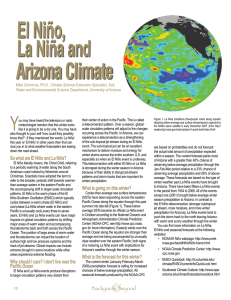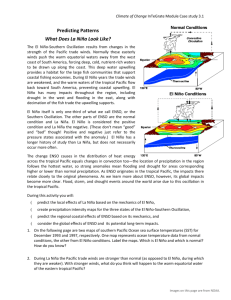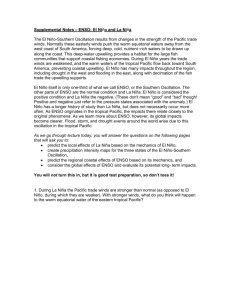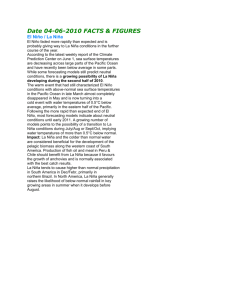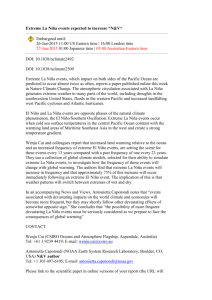Dec. 1999 WINTER PRECIPITATION UPDATE Paul W. Brown Extension Specialist, Biometeorology
advertisement
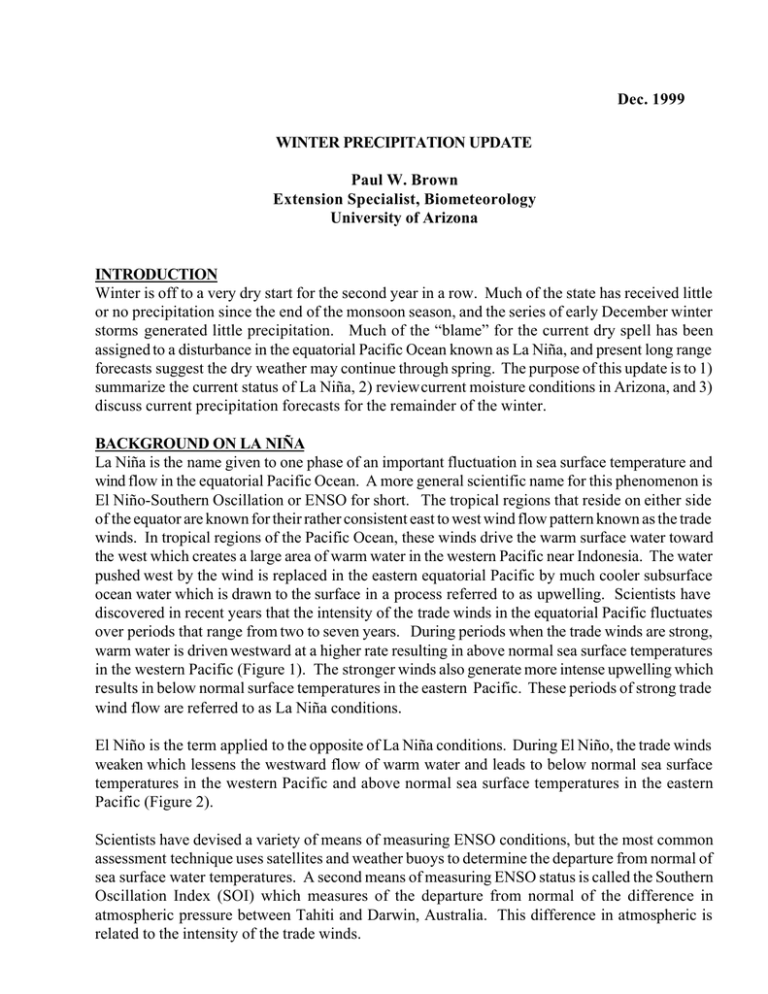
Dec. 1999 WINTER PRECIPITATION UPDATE Paul W. Brown Extension Specialist, Biometeorology University of Arizona INTRODUCTION Winter is off to a very dry start for the second year in a row. Much of the state has received little or no precipitation since the end of the monsoon season, and the series of early December winter storms generated little precipitation. Much of the “blame” for the current dry spell has been assigned to a disturbance in the equatorial Pacific Ocean known as La Niña, and present long range forecasts suggest the dry weather may continue through spring. The purpose of this update is to 1) summarize the current status of La Niña, 2) review current moisture conditions in Arizona, and 3) discuss current precipitation forecasts for the remainder of the winter. BACKGROUND ON LA NIÑA La Niña is the name given to one phase of an important fluctuation in sea surface temperature and wind flow in the equatorial Pacific Ocean. A more general scientific name for this phenomenon is El Niño-Southern Oscillation or ENSO for short. The tropical regions that reside on either side of the equator are known for their rather consistent east to west wind flow pattern known as the trade winds. In tropical regions of the Pacific Ocean, these winds drive the warm surface water toward the west which creates a large area of warm water in the western Pacific near Indonesia. The water pushed west by the wind is replaced in the eastern equatorial Pacific by much cooler subsurface ocean water which is drawn to the surface in a process referred to as upwelling. Scientists have discovered in recent years that the intensity of the trade winds in the equatorial Pacific fluctuates over periods that range from two to seven years. During periods when the trade winds are strong, warm water is driven westward at a higher rate resulting in above normal sea surface temperatures in the western Pacific (Figure 1). The stronger winds also generate more intense upwelling which results in below normal surface temperatures in the eastern Pacific. These periods of strong trade wind flow are referred to as La Niña conditions. El Niño is the term applied to the opposite of La Niña conditions. During El Niño, the trade winds weaken which lessens the westward flow of warm water and leads to below normal sea surface temperatures in the western Pacific and above normal sea surface temperatures in the eastern Pacific (Figure 2). Scientists have devised a variety of means of measuring ENSO conditions, but the most common assessment technique uses satellites and weather buoys to determine the departure from normal of sea surface water temperatures. A second means of measuring ENSO status is called the Southern Oscillation Index (SOI) which measures of the departure from normal of the difference in atmospheric pressure between Tahiti and Darwin, Australia. This difference in atmospheric is related to the intensity of the trade winds. ENSO AND ARIZONA WEATHER Many Arizonans would agree that our climate has little in common with that of the tropical Pacific. However, ENSO events do impact weather in both the subtropical and temperature latitudes of the United States. Changes in sea surface temperature during ENSO events impact the general circulation of the atmosphere, especially during the winter months. When La Niña conditions prevail, the main winter storm track tends to be displaced northward into the Pacific Northwest which leads to a reduction in the frequency and intensity of winter storms that impact the Southwest (Figure 1). Winters in the Southwest are generally dry during La Niña events. In contrast, the El Niño phase of ENSO tends to displace the winter storm track farther south, placing Arizona and the Southwest in the path of a greater number of more intense storms (Figure 2). Winter precipitation is typically above normal in the Southwest when El Niño conditions prevail. In fact, nearly all of the region’s serious floods have occurred when ENSO was in the El Niño phase. The impact of ENSO on winter weather is evident in Table 1 where precipitation statistics (Nov.Apr.) are provided for each of Arizona’s seven climate divisions (Figure 3) during years when definitive La Niña and El Niño conditions prevailed between 1933 and 1999. On average, precipitation is much greater during El Niño winters as compared to La Niña winters. Precipitation in southern Arizona during El Niño is nearly double the level received when La Niña conditions prevail. The enhancement in winter precipitation during El Niño is less dramatic in northern Arizona, but still runs 50-75% higher than when La Niña conditions prevail. Table 1 also provides some information on the predictability of precipitation during definitive ENSO events. Above normal precipitation has resulted about 70% of the time when El Niño conditions prevail. Winter precipitation patterns seem a bit more predictable during La Niña events. Below normal precipitation has resulted 80-90% of the time when ENSO is in the La Niña phase. A quick count of the number of winters listed in Table 1 gives a total of 34 or about 50% of the winters since 1933. What about the remaining 50% of winters when neither El Niño nor La Niña prevails? These winters exhibit what should be considered normal winter precipitation patterns. Precipitation during these 33 winters averaged near normal and the number of winters with above and below normal precipitation were roughly equal. CURRENT STATUS OF ENSO The current status of ENSO is less well defined than last winter when definitive La Nina conditions were evident. ENSO indices based on sea surface temperatures indicate weak to moderate La Nina conditions continue while other indices such as the SOI suggest ENSO is approaching the intermediate phase where neither El Niño nor La Niña conditions prevail. Forecasters with the National Oceanic and Atmospheric Administration’s Climate Prediction Center (CPC) observed some strengthening in La Niña in November and their forecast models indicate La Niña should continue through April of 2000. CURRENT MOISTURE STATUS Several drought indices are available to assess the status of regional moisture conditions in Arizona. A common index is the Modified Palmer Drought Severity Index (MPDSI) which estimates the water balance of soils over large geographic areas. The MPDSI generates a numerical value which can be used to assess the relative moisture status of an area. The National Climate Data Center updates the MPDSI each month. Table 2 provides MPDSI moisture assessments for each Arizona climate division for the months of September and November. The moisture conditions at most locations were classified as normal to slightly wet in September due to a relatively wet monsoon season. However, moisture conditions have deteriorated in October and November due to a lack of precipitation, and most of the state is now classified in the mild drought category. An exception to the general statewide rule is northwest Arizona. Here, the summer rains were insufficient to relieve existing drought conditions, and the MPDSI remained in the mild drought category at the end of September. The dry fall weather has now placed northwest Arizona in the severe category for drought. PRECIPITATION FORECAST FOR REMAINDER OF WINTER The Climate Prediction Center (CPC) expects precipitation to continue below normal in the southern U.S. for the next few months. The CPC’s Monthly forecast for January and Seasonal Forecasts for January through May indicate below normal precipitation is the most likely outcome for the next 150 days. This is certainly an unwelcome forecast, given the lack of fall moisture. It now appears that precipitation in December will be light which will add further to the dryness in the state. Analyses by CPC of past ENSO events offers some hope for January precipitation. January tends to be the winter month least likely to follow the typical ENSO trend for precipitation. Table 1. Winter precipitation (November to April) and the number of years with above and below normal precipitation during years with definitive La Niña and El Niño conditions. Period of record is 1933 to 1999 (67 years). Data acquired from the Western Regional Climate Center. WINTER PRECIPITATION ALL WINTERS LA NIÑA CONDITIONS EL NIÑO CONDITIONS (13 Winters) (21 Winters) CLIMATE ZONE Average Inches Average Inches Yrs. + Normal Yrs. - Normal Average Inches Yrs. + Normal Yrs. Normal Northwest 5.30 3.95 2 11 6.79 15 6 Northeast 6.82 5.17 1 12 8.07 13 8 North Central 8.00 5.59 2 11 9.72 14 7 East Central 10.21 7.41 2 11 12.05 12 9 Southwest 2.50 1.55 3 10 3.39 15 6 South Central 5.47 3.61 1 12 6.89 13 7 Southeast 5.28 3.31 0 13 6.91 13 8 Table 2. Moisture status for each of Arizona’s seven climate divisions for September and November 1999 as derived from the Modified Palmer Drought Severity Index. CLIMATE DIVISION SEPTEMBER MOISTURE NOVEMBER MOISTURE Northwest Mild Drought Extreme Drought Northeast Moderately Wet Mild Drought North Central Slightly Wet Mild Drought East Central Slightly Wet Mild Drought Southwest Normal Mild Drought South Central Slightly Wet Mild Drought Southeast Slightly Wet Mild Drought STORM TRACK DRY STRONG TRADE WINDS WARMER COLDER LA NINA Figure 1. Graphical depiction showing the important features of the La Niña phase of ENSO. Strong trade winds produce above normal sea surface temperatures in the western and below normal surface temperatures in the eastern equatorial Pacific Ocean, respectively. The winter storm track is displaced north into the Pacific Northwest and results in dry conditions for the Desert Southwest. STORM TRACK WET WEAK TRADE WINDS COOLING WARMING EL NINO Figure 2. Graphical depiction showing important features of the El Niño phase of ENSO. Weak trade winds produce below normal sea surface temperatures in the western and above normal surface temperatures in the eastern equatorial Pacific Ocean, respectively. The winter storm track is displaced southward across the southern U.S. and results in wet conditions for the Desert Southwest. Figure 3. Map showing the official Arizona Climate Divisions. Key: 1 = Northwest; 2 = Northeast; 3 = North Central; 4 = East Central; 5 = Southwest; 6 = South Central; 7 = Southeast.
